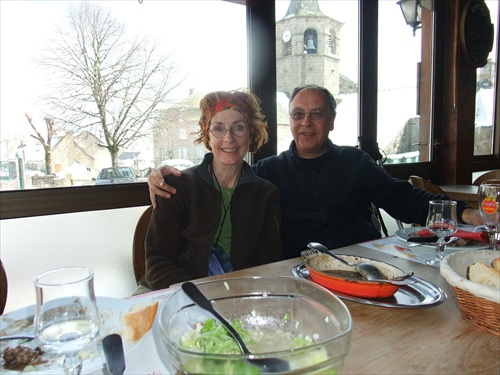
The stage to Saugues was memorable by the addition of a fourth member to our little group: Cecil, who manages to be German, English, Sri Lankan and Hakka Chinese. Our conversations that day were wondrously accented. Such is the Camino. No wonder that control freak, Louis XIV, didn’t like the hike.
The photo above was taken some days later, because rain, wind and cold made pausing hard on the haul to Saugues. I recall a steep ascent from the river Allier with its hydro dam and striking volcanic formations, a Madeleine chapel in the rock…and increasing doubts about my rain gear. Read the forums and learn, Pilgrim!
Sauges, when we got there, had a very well appointed gîte communal, a kind of joint accommodation for pilgrims and tourists run by local authorities. Sharing a dormitory with non-snoring friends, and a large kitchen with considerate French randonneurs on their annual holiday, gave me a good early experience of joint accommodation on the Camino. (I had different experiences later!)
***

Saugues has a famous church (looking bleak that day) and still more famous landmark, the Tour des Anglais, the Tower of the English.

It’s not the only French tower to bear such a name, and the word anglais conjures a past that has left a far deeper mark on France Profonde than multiple revolutions, two world wars and the humiliating defeat by Prussia. The ghost that haunts this part of the world presides in that tower, has been there for seven hundred years, and won’t be leaving soon.
But more on that later.
There’s more scary stuff about this region: the Beast!

The Beast of Gevaudan now has its own museum in Saugues. The bare bones of the story: a wolf-like creature ravaged the countryside for several years, killing over a hundred humans, till its (uncertain) termination in 1767.
Much of what’s said about the Beast is fanciful or speculative; but it’s important to remember that it did exist, and that the hundred deaths are real. There was intense public interest at the time, and considerable fear, and reputations did go on the line as even Louis XV took a close interest. An enthusiast’s account of the whole affair can be found here.
What’s special is the story’s ability to stretch, morph and resonate. The natural meets the preternatural meets the supernatural. Ancient France disturbs the new rationality, a peasant child’s gory death in the snow shakes the far away salons and even the throne.
Werewolf believers and cryptozoologists can’t get enough of it. Not into conspiracies, mysteries, myths, symbols, cover-ups? Well someone is. Just look at the book rack at the airport.
Most striking to me is how well some of the spin-off stories would serve as urban myths for modern teenagers. A little girl follows her brother who has been snatched by the beast, finds him tranquilly asleep in the forest. He seems okay…till his sister observes that his insides have been sucked out.
There’s something for everyone in the story of the Beast. Expect a Dan Brown novel where the forces of conservatism are out to discredit Voltaire and save the ancien régime.
A little take of my own? David Attenborough once said that the single most important thing he knew about animals is that they are individuals. I live in the bush surrounded by all kinds of animals.

For some years an animal will behave a certain way, then change its behaviour, either because it has learnt something or because it has been forced to change. Adventurous members of a species can try things that others of the same species won’t. Then the radical will teach the cautious something by suffering or succeeding. An example: I used to have thousands of pieces of sweet fruit per year, for many years, without netting or guard dogs. Now I have none, not even the citrus that abounds on my acres. Possums, wallabies and birds have learnt to devour all. All!
Between the middle ages and the nineteenth century climate was cool in Europe, but not uniformly so. There were periods where both temps and rainfall were higher. It’s interesting to note that according to some records the 1760’s were harsh, but had been preceded by a couple of markedly good decades.
Could a sudden shortage of sustenance after a period of abundance cause a radical change in animal behaviour?
Read Full Post »

































